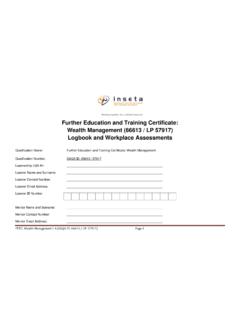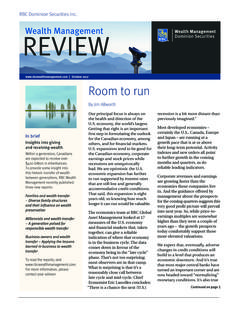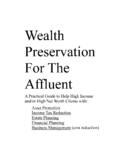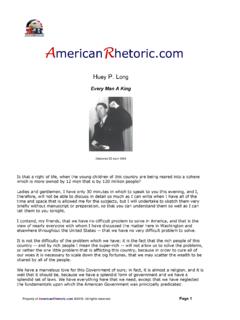Transcription of ww S TATISTICS BRIEF - oecd.org
1 Ww STATISTICS BRIEF . June 2015 - No. 21. 3 Household wealth : key Household wealth inequality concepts and guidance for measurement across OECD countries: new OECD. 3 Levels of household wealth across countries evidence 4 How does wealth by Fabrice Murtin and Marco Mira d'Ercole inequality compare across countries? 5 Demographic characteristics The evidence of higher income inequalities in most OECD countries has recently of indebted and over- attracted much attention from both policy-makers and the media as witnessed indebted households by the debate that followed the publication of Thomas Piketty's book Capital in the 7 Trends in household 21st Century (2014) and by the very large number of studies on changes in income wealth since the Great inequality. There is, however, much less evidence on inequality in the distribution Recession of household wealth , both within and between countries.
2 In fact, even today, 7 Conclusions no international standards exist that National Statistics Offices and other data producers could use when gathering data on wealth distribution. This situation is, however, rapidly changing. In 2013, the OECD issued a set of Guidelines' for micro statistics on household wealth (OECD, 2013) and an increasing number of countries have engaged in the collection of micro statistics in this field (European Central Bank, 2013). Building on these initiatives as well as others, such as the Luxembourg wealth Study (Sierminska et al, 2006) which have informed previous OECD analysis (Jantii et al., 2008), the OECD has now collected a new set of data on the distribution of household wealth for 18 OECD countries, based on the set of conventions and classifications proposed in the 2013 OECD Guidelines.
3 This Statistics BRIEF presents this new OECD wealth Distribution Database released on 15 June 2015, and provides some empirical results drawing on more extensive analysis in Murtin et al. (2015). Preliminary results were presented in In It Together: Why Less Inequality Benefits All (2015). Evidence from this database for 18 OECD countries highlights large differences in wealth holdings across OECD countries. Moreover, wealth inequality is much larger than income inequality due to financial assets that are very unequally distributed and mainly accrue to top income and top wealth households. Over the long run, the increase in the price of shares and housing relative to consumer goods has been one of the main drivers of higher household wealth , while the real appreciation of shares prices has also increased wealth concentration.
4 This trend was not reversed by the financial crisis in the United States, the Netherlands and the United Kingdom where wealth inequality at the top of the distribution has grown markedly, while smaller changes have been observed in Australia, Canada and Italy. Human capital is also correlated with higher wealth as well as higher incomes and earnings: households headed by a college graduate have a net wealth that, on average, is significantly higher than households whose head has an upper Organisation for Economic Co-operation and Development Box 1: A new set of OECD statistics on the distribution of household wealth The data in the OECD wealth Distribution Database are based on national sources. A subset of the information collected is available to users in the OECD dissemination platform ( aspx?)
5 Datasetcode= wealth ). Estimates referring to the most recent year (generally 2010) are currently available for 18 OECD countries, while estimates referring to more than one year are available for six. Countries included are Australia, Austria, Belgium, Canada, Finland, France, Germany, Greece, Italy, Korea, Luxembourg, the Netherlands (based on two different sources), Norway, Portugal, the Slovak Republic, Spain, the United Kingdom (limited to Great Britain) and the United States. For seven countries, estimates were obtained through a questionnaire completed by national contact points in national statistics offices and other producers of official statistics ( central banks) that regularly collect micro-level information on household wealth ; among them, estimates for Australia, Canada, Korea, the United Kingdom and the United States are based on household surveys, while those for the Netherlands and Norway are based on tax and administrative records.
6 For 11 countries (participants in the Euro-System Household Finance and Consumption Survey), estimates for the most recent year were computed by the OECD based on the public use file provided by the European Central Bank (complemented, in the case of France and Italy, by estimates for earlier years provided by national contact points). The data in the OECD wealth Distribution Database share the following characteristics: They refer to the distribution of real and financial assets and liabilities across households (rather than across persons or adults), with no adjustment made to reflect differences in household size (which is the convention used by the OECD when analysing the distribution of household income). The data also refer to the assets and liabilities held by private households resident in the country.
7 Assets and liabilities are classified based on the nomenclature proposed by the OECD Guidelines. This nomenclature distinguishes between five categories of non-financial assets, eight categories of financial assets, and three categories of financial liabilities. Among financial assets, assets held in the form of pension schemes related to employment are reported as a separate category (the data shown below refer to a narrower definition of household wealth that excludes these assets from the total). Information is collected on net household wealth broken down by housing status (three groups), age of the household head (six groups), number of household members (five groups), household type (six groups), education of the household head (four groups), main source of income (five groups), and wealth and income quintiles (with additional breakdowns for the top 10%, 5% and 1% of the distribution).
8 Information is also collected on the share of households holding various types of assets and liabilities; on the mean value of assets and liabilities for households holding them; on the joint distribution of household wealth and income across household quintiles; and on the extent of over-indebtedness across households based on two measures of over-indebtedness (debt-to-asset ratio above 75%; and a debt-to-income ratio exceeding 3). Despite efforts to ensure common treatments and classifications across countries, the measures included in the OECD wealth Distribution Database are affected by differences that limit their comparability. Two of the most important are: i) differences between countries in the year the data was collected (ranging between 2010. and 2013, for the most recent observation); ii) differences in the degree of oversampling of rich households across countries.
9 With respect to the latter, differences (ranging between no oversampling for Australia, to large oversampling for the United States and Spain) may affect international comparisons of both levels and concentrations of household wealth as, in all countries, most wealth is typically held by the richest households. Statistics BRIEF - June 2015 - No. 21 2. secondary education and more than three times follows closely the one used in the System higher than those with only a primary education. of National Accounts, the Guidelines depart Over-indebtedness affects mostly households with from it in some cases in order to better a young head, while both prevalence and depth support distributional analysis ( they of debt are particularly high in the United States, include consumer durables among assets, the Netherlands and Norway.)
10 As these are particularly important for poorer households; they include net equity in own unincorporated business among financial Household wealth : key concepts and assets, as households may not be able to guidance for measurement distinguish them from shares in corporations). The concept of wealth used in the OECD These Guidelines were prepared by the OECD. Guidelines refers to ownership of economic and a team of national statisticians and experts, capital' as a dimension of people's material and informed by the results of an inventory of well-being (alongside income and consumption); measurement initiatives in this field. The OECD. hence it excludes other types of capital (such as wealth Distribution Database (Box 1) follows the human capital, social capital and collectively held conventions and definitions recommended in these assets) that, while important for individuals and Guidelines.
















